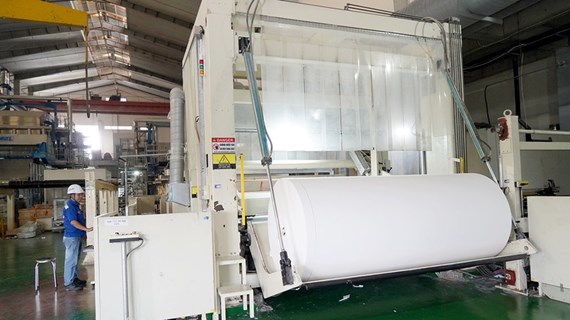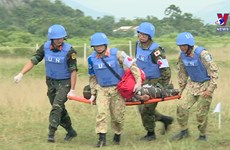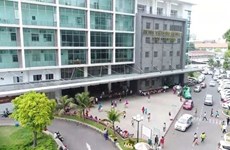Ho Chi Minh City to revamp emergency services
Ho Chi Minh City Department of Health's plan on developing medical emergency service system this year and calling for private sector's investment for the field will help improve the service's quality,
 Illustrative image (Source: VNA)
Illustrative image (Source: VNA)In 2013, only around one percent of 831,499 those hospitalised for emergency aid were brought to hospitals by ambulances, according to the department's statistic.
Many of them died on the way or got disabilities in the rest of their life because of not ensuring proper medical care during transporting.
Speaking at a recent meeting, Dr Nguyen Ngoc Duy, the department's Head of General Planning Division, said that providing emergency aid to patients on the spot and quickly transporting them to the nearest health facilities was critical to ensure safety.
Developing medical emergency services, including pre-hospital emergency systems, was one of 10 solutions which the department would focus on to improve quality of health examination and treatment, Duy said.
The 115 Medical Emergency Centre last year set up two satellite emergency aid stations at Binh Tan Hospital in Binh Tan district and Saigon General Hospital in District 1.
"Establishment of the stations meets resident's demand. Last year, the centre received 9,795 calls," he said.
"However, the number of stations is too low compared to the city's population of 10 million, including migrants and an increase in the number of the elderly," he added.
Anther problem is traffic jams, particularly in rush hours, that prevent timely arrival at hospitals.
As part of the department's plan, the centre this year will have at least three more stations in the districts of Hoc Mon, Thu Duc and 7.
He said it was necessary to ensure a sufficient number of doctors and nurses as well as ambulances for these centres.
Dr Tang Chi Thuong, the department's deputy head, however, said it was difficult to recruit personnel to work in emergency aid.
"We will create more paramedic jobs by offering courses to people in HCM City," Thuong said, adding that such training had never been conducted in Vietnam.
He said that Australian universities would provide professional assistance to the city's Pham Ngoc Thach Medical University to set up international standards.
The department has also encouraged private universities with medical majors to offer training in emergency care.
Private sector
Dr Le Truong Giang, Chairman of the Public Health Association, said that a large investment from the private sector was needed to help develop the city's emergency system.
Thuong said that the department was considering ways to attract investment from the sector.
On February 26, the Van Khang SOS Company launched an SOS emergency centre.
Le Truong Minh, the centre's deputy director, said it would connect to the city's 115 Centre to serve people better.
In cases of disasters and natural calamities in the city and neighbouring provinces, it also would be part of the city's first responder care, he said.
Giang said that the Van Khang SOS had signed an agreement with the city's Red Cross Society to provide help in emergency aid cases.
The society had set up 1,000 emergency stations, he said, adding that many of them had not been sufficiently equipped with devices for emergency aids.
In the agreement, the centre would provide devices like mobile phones to staff at 200 stations.
Patients in need of emergency care can press an SOS button on their device to ask for assistance from the centre.
The Van Khang SOS Centre, whose system operates in districts 1, 3, 5, 10 and Phu Nhuan, will expand its services beginning in May.
The SOS Centre will provide specialised devices to both patients and staff. The device connects the mobile phones of doctors and nurses and patients' relatives.
The service will first be directed toward patients with chronic conditions and the elderly.
The mobile phones will have a positioning system, which will allow the doctor to know the location of the patient.
In case of emergency, the centre's doctors and nurses will leave by motorbike, rather than by ambulance, to reach the destination quickly.
The motorbike will be able to travel quickly through narrow alleys.
The motorbikes are equipped with equipment for emergency aid, such as mini oxygen containers, electrocardiogram machines and other devices.
"On the way, the doctor will be able to give guidance to people on the phone and help them provide assistance to the patient," Minh said.
Ron McDaniel, Senior Vice President of Priority Dispatch Corp, which provides emergency dispatch technologies in the US, said that it was important to give patients instructions while they wait for ambulances to come to their home.
McDaniel spoke at a recent graduation ceremony of the first emergency medical dispatcher course in Vietnam at HCM City-based Family Medical Practice Vietnam.
The Family Medical Practice clinic this year will launch an emergency medical response centre in HCM City that will provide further medical advice to patients or their relatives who call for emergency aid as they wait for an ambulance.
Its clinics nationwide have fully equipped ambulances on stand-by 24 hours a day.
The ambulances are used as responders to emergency medical services within the city. They also can transfer up to two patients with complicated cases from around the country.-VNA













